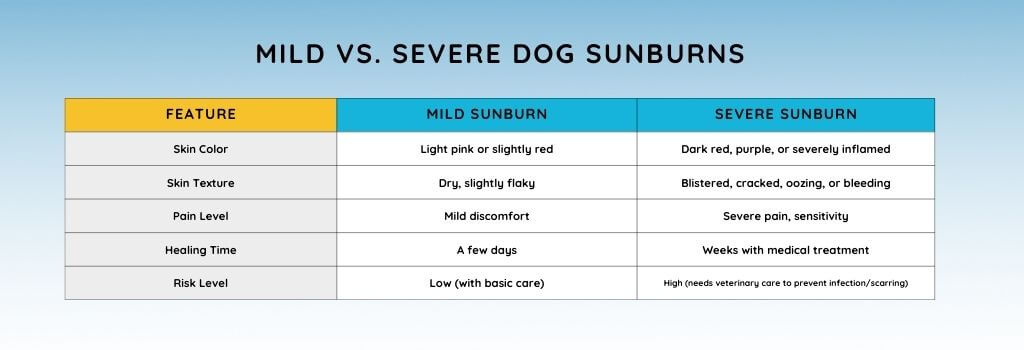When temperatures start to heat up and the days grow longer, people and their pets naturally begin spending more time outdoors exploring nature, catching up on yard chores, or simply soaking up the sunshine. Just like us, most dogs enjoy the warmer weather. As pet parents, we fill their days with walks, games of fetch, and sunbathing while we take care of all the yard chores we previously mentioned.
While sun exposure is natural and good for dogs in moderation, owners should be aware of the risks of their dogs spending too much time out in the sun. Most dog owners are already well aware of heat-related conditions like heatstroke and dehydration and do their best to provide shade, fresh water, and cool places for their pets to rest.
However, one risk that's often overlooked is sunburn in dogs — and it can have serious consequences if not prevented. In this blog, we’ll be sharing all of the facts on dog sunburn, including signs your dog is getting too much sun, symptoms of both mild and severe burns, and when it’s time to get your veterinarian involved in your dog’s sunburn treatment.

Can Dogs Get Sunburn?
YES! Even though they are covered in fur, dogs can still get sunburned! While their fur will offer some protection, it isn’t enough to fully block all UV rays. Dogs are especially vulnerable to the damaging effects of the sun during peak UV hours – typically 10 a.m. to 4 p.m. – and when they're outside for extended periods without access to shade or protective gear.
Dog sunburns are most likely to occur when dogs are spending more time outside and the UV index is high, making spring and summer prime times for this type of skin damage to occur – especially on clear, sunny days.
Some areas on dogs are more prone to burn based on their tissue/ muscle build and thinner hair covering:
- Ears (tips and edges)
- Nose
- Eyelids
- Mouth (lips and edges)
- Belly
Sunburns on dogs can develop a lot faster than you’d think, with some dogs experiencing signs of sunburn in as little as 30 minutes when directly exposed to the sun and with the right conditions.
Factors That Can Contribute to Sunburn in Dogs
While any dog can get a sunburn, there are a few factors that can increase the likelihood of your dog feeling the heat and developing a sunburn. A dog’s coat color, length, and density can all affect the amount of UV protection their fur offers, making them more or less susceptible to sunburns. Other factors like where they spend their time, as well as illness or age-related skin conditions or hair loss, also play a role in a dog’s likelihood of getting sunburnt.
A few common dog sunburn factors to keep an eye on include:
- Light-colored dogs (white, cream, ginger) with fair skin underneath
- Short-haired breeds like Pit Bulls, Boxers, Dalmatians, and Greyhounds
- Hairless breeds like the Chinese Crested or American Hairless Terrier
- Dogs with bald spots or areas of thin fur
- Dogs who spend a lot of time outdoors
If your dog doesn’t have any characteristics included on that list, that doesn’t mean you’re in the clear. Any dog can suffer from a sunburn under the right conditions, so it’s crucial for owners to monitor their dog’s time outside in the sun and take the proper precautions to fully protect their dog’s skin.
Sunburns in dogs can lead to a number of secondary health complications, like infections or undesired skin changes, as well as life-threatening conditions like cancer. With dog sunburns able to cause so much lasting and negative damage to a dog’s health, preventing dog sunburns should be top of mind for owners every time they take their pet outside for more than a few minutes.
Signs Your Dog Has a Sunburn (And When You Need to See a Vet)
Now that we’ve cleared up that dogs can, in fact, get sunburns, you’re probably wondering, “What does dog sunburn look like?” Light sunburns may be difficult to spot, but dog sunburns generally share a lot of the same characteristics as the sunburns we experience on our own skin.
The affected skin will usually take on a pink or reddish appearance, depending on the severity of the burn and its location on the dog’s body. Some dogs may scratch or nip at the affected area in an attempt to get some relief from the discomfort or unusual feeling.
If your dog is outside and you notice any of these common signs of a dog sunburn, it’s PAST TIME to bring them inside.
- Pink or red skin, especially in exposed areas
- Skin that feels warm, dry, or tender
- Flaky or crusty patches
- Itchiness or scratching at the area
- Blisters or sores
- Curling or dry edges of the ears
- Hair loss in the affected area
In more severe cases dogs with severe sunburn may have:
- Mild fever
- Skin ulcers or infections
- Lethargy or signs of pain
These more severe cases of sunburn in dogs are often considered emergencies and warrant immediate medical attention for your dog. Seek immediate veterinary care if:
- Skin turns dark red or purple
- Blisters form and ooze pus
- Your dog stops eating or drinking
- Signs of dehydration (lethargy, dry gums)
- Your dog is in severe pain or can’t move comfortably

How to Treat a Dog’s Sunburn
How to treat a dog sunburn will primarily depend on the sunburn’s severity. Let’s take a closer look at the varying degrees of sunburns in dogs and what treatment options are available for them.
Mild Dog Sunburn
Mild sunburns don’t require much treatment, and owners will typically need to focus on keeping their dog comfortable over the next few days while the sunburn and any accompanying side effects like itching or skin tenderness resolve on their own.
If your dog has slightly pink skin and no pain, you can try:
- Use cool compresses on the area.
- Try a gentle oatmeal bath.
- Apply pet-safe aloe vera (no added alcohol or fragrances).
Moderate to Severe Dog Sunburn
Moderate to severe sunburns in dogs are a much more serious matter and will require professional attention, as they are often painful and prone to infection. These sunburns are typically very uncomfortable or even painful for dogs and have the potential to do lasting damage to a dog’s skin.
If the symptoms of your dog’s sunburn worsen or new signs appear, contact your veterinarian. Depending on the severity of the burn, treatment options employed by your veterinarian may include:
- Pain relief medications
- Antibiotics for infection
- Cold laser therapy
- Topical creams or ointments
Be sure to keep your dog completely out of the sun until they are fully healed. After recovery, protective measures are crucial to prevent future sunburn and reduce the risk of skin cancer.
Don't have a vet in your area yet? We can help you find a local veterinarian.
If you have more questions, the GeniusVets Teletriage platform will give you unlimited access to text and/or video calls with board-certified veterinarians! To learn more click here.


The Ultimate Guide
to Dog Care
This free guide is an indispensable manual for dog ownership. Filled with veterinary advice and recommendations on every important topic at each stage of your dog’s life, this is all the stuff that responsible dog owners need to know. That is why we are making it free!
